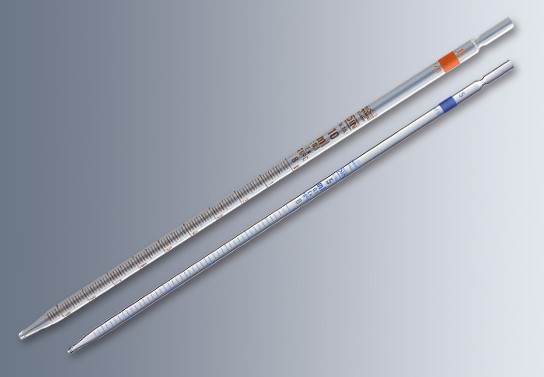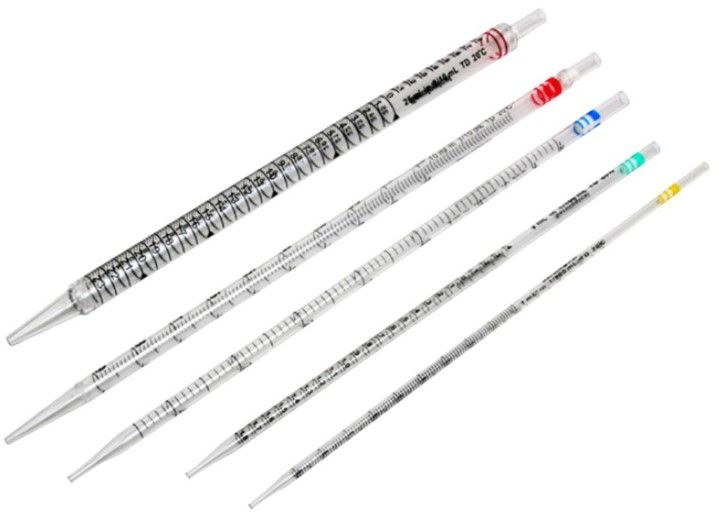- 📌 What is a graduated pipette?
- 🔹 Using the graduated pipette
- 🍀 Types of graduated pipette
- 👉 Difference between graduated pipette and a Burette
- 🌳 Differences between graduated and volumetric pipette
- 📌 Difference between graduated and volumetric pipette
- 🔹 Graduated pipette function
- Manufacturers of graduated pipettes
A graduated pipette is worked by creating a partial vacuum above the liquid retention chamber, to suck liquid, while the partial vacuum is released to pump liquid.
Historically, the accuracy of a graduated pipette was not as good as that of a volumetric pipette (accuracy of 3 significant figures); however, with manufacturing methods improved, the accuracy indicated by the manufacturer may be equal to that of a volumetric pipette.
Experts note that graduated pipettes have higher accuracy than the Pasteur pipette. Have tolerances ranging from ±0.6% to ±0.4% of nominal volume when measured at 20 °C (68°F).
Graduated pipettes are manufactured in accordance with ISO specifications for the accuracy and arrangement of graduation.
Grade A and AS pipettes they have the highest accuracy, while the S stands for "delivery fast». These allowed margins of error are identical to those of the DIN EN ISO standards.
Grade B pipettes they usually have twice the error compared to grade A pipettes and AS. These pipettes commonly come in volumes of 5, 10, 25 and 50 ml.
Some have been developed varieties of propipetters [clarificación necesaria], both manual and electrically assisted.
Originally pipettes were made of sodocalcium glass, but currently many are made of borosilicate glass; disposable graduated pipettes are often made of polystyrene.
📌 What is a graduated pipette?
A graduated pipette is a pipette that has its volume marked over the entire length of the tube. They are necessary to measure with great precision and to perform the transfer of a liquid from one container to another.
They are usually made with plastic or glass materials, they have a conical-shaped tip. Have maracas in all its extension, these indicate the existing volume of a point to other.
With small pipettes it is possible to obtain a more accurate measurement of the fluids, on the other hand, with a large pipette it is possible to carry out measurements when the requirements in precision they are not so critical.
Accordingly, pipettes vary in volume, with most measuring between 0 and 25.0 milliliters (0.00 and 0.88 imp fl oz; 0.00 and 0.85 US fl oz).
🔹 Using the graduated pipette
Graduates pipettes have a scale divided into one and 1/10 milliliter units. They are used when taking a volume of solutions in which the accuracy does not necessarily have to be high.
🍀 Types of graduated pipette
There are two types of pipettes that differ depending on the location of the markings with reference to the tip of the pipette, these are: Mohr Pipettes and Serological pipettes.
Its further differentiation significant is in the position of the first graduation mark to be find it closer to the tip of the pipette.
Mohr's pipette.
This pipette has been designed to be used as a drainage pipette. On the straight tube, it has markings indicating the volume changes of 0.10 milliliters (0.0035 imp fl oz; 0.0034 US fl oz).
This pipette lacks the first graduation mark (the one that is lower), appears far after the base of tip. The person in charge of using this pipette may make an error by improper use, if there is a crack or break in it.
Serological Pipette.
This pipette has been developed for use as a blowing pipette. The graduation marks of this pipette are located near the end of the tip.
The pipette can be blown by gravitational force or air pressure. The rubber bulbs attached to the end opposite to the tip are commonly used to "blow" any remaining solution.
The fact that the solution remains in the pipette can affect an experiment by allowing a discrepancy between what is measured and what is transferred. The designation of whether the pipette is "to deliver" (TD) or "to contain" (TC) is marked on most serological pipettes.


On the other hand, the pipettes graded are classified into types ranging from one to three.
The type 1 and type 3 pipettes they have the nominal value at the bottom (zero at the top).
However, when it comes to the type 1 pipette, the solution for all volumes is delivered so partial.
For type 3, the solution is fully supplied only to the nominal value. Type 2 pipettes have the nominal value at the top (zero at the bottom) and the solution is fully supplied for any volume.
👉 Difference between graduated pipette and a Burette
A burette looks like a graduated cylinder with a stopcock at the bottom.
They can be used for transfer liquids, but they are mostly used in titrations, in which no it is known what volume is going to be needed at the beginning.
Can control the flow of the liquid using the stopcock. You can open it completely to allow a continuous flow or set it to drip one drop at a time. One drop is
0.05 mL.
Flow control is what allows burettes to be used in titrations. You can slowly add a desired amount of liquid until it reaches its equivalence point and measure the amount of liquid you have dispensed.
🌳 Differences between graduated and volumetric pipette
The volumetric pipettes are they are used to transfer an exact amount of liquid with high accuracy. Your margin of error at 20 degrees Celsius is +/- 0.02 mL (varies according to the manufacturer, class and size).
They are used to transfer anything from 1 mL to 50 mL and when accuracy is of the utmost importance.
Micropipettes are also a type of volumetric pipettes. They also have a high accuracy, but they they are used to transfer very small amounts of liquid, often less than 1 mL.
It is usually more accurate using a volumetric pipette to transfer large amounts of liquid because if a micropipette is used several times to transfer the same amount in fact, the error is spreading.
Those with multiple channels (tips) are often used in fields such as microbiology/biochemistry when so many samples have to be prepared at the same time. They are more efficient.
📌 Difference between graduated and volumetric pipette
Volumetric pipettes transfer a lot of solution, very accurately. They can only be used for the liquid supply for which it has been calibrated.
This type of pipettes has narrow tips and in the center there is an expansion that resembles the bulb type. In the section of the tube, above the central expansion, you can see the calibration mark, the only one that this type of pipettes has.
🔹 Graduated pipette function
These types of pipettes are used for the accurate measurement and transfer of liquid volumes of a container to another. They are usually made of plastic or glass and their
tip is conical.
In the following video you will be able to appreciate the correct use of the pipettes and the precautions that must be taken into account.
Manufacturers of graduated pipettes
- Gilson: https://www.gilson.com/
- Eppendorf: https://www.eppendorf.com/
- VWR: https://us.vwr.com/
- Sartorius: https://www.sartorius.com/
- Thermo Fisher Scientific: https://www.thermofisher.com/
- Mettler Toledo: https://www.mt.com/
- Corning: https://www.corning.com/
- Rainin Instrument: https://www.rainin.com/
Please note that these links may not be available in all regions, and that the availability of specific products may also vary based on your location.

